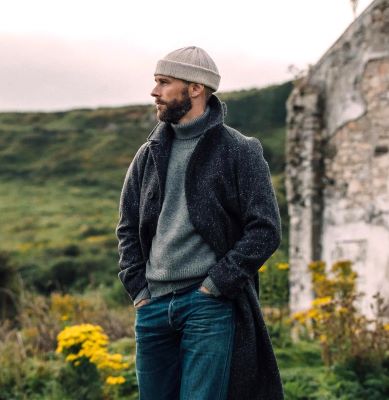
The verdant landscapes, rugged coastline, and Gaelic traditions of Donegal, Ireland, have inspired tales of wonder and history. Central to this historical tapestry is the evolution of Donegal Tweed weaving, a craft that encapsulates the very essence of the region. Woven into the fabric are not just threads, but stories of families, culture, and an enduring legacy.
Origin of Donegal Tweed Weaving
The art of weaving has ancient roots in Ireland, dating back to prehistoric times. Initially, simple wooden looms were used to craft everyday items. By the time of the Celts, this craft had transformed into an art form, with intricate designs and patterns depicting stories and traditions. Donegal Tweed, distinct for its colorful flecks and rugged texture, emerged as a material best suited for the unpredictable Irish weather. Made from 100% wool, the fabric’s resilience and warmth made it a staple for those living in the often-harsh Donegal environment.
Characteristics of Donegal Tweed
Two primary features distinguish Donegal Tweed:
Neps: These are the small, colored flecks incorporated into the yarn during the spinning process. Derived from different colored wool, these neps give Donegal Tweed its signature appearance.
Herringbone Pattern: Traditionally, Donegal Tweed is woven in a herringbone pattern, creating a V-shaped weaving pattern resembling the bones of the herring fish.
Magees of Donegal
-History & Evolution
Among the most prominent names associated with Donegal Tweed is Magees of Donegal. Established in 1866 by John Magee as a small draper’s shop in Donegal Town, it began specializing in handwoven tweed. By the 20th century, Magees had expanded its operations. Recognizing the unique charm and quality of Donegal Tweed, they began to not just sell but also manufacture the fabric, introducing it to wider markets and audiences.
-Magees Today
Today, Magees is a hallmark of authenticity and tradition in the world of Donegal Tweed. While modernization has introduced new designs and patterns, the core essence of handwoven craft remains central to Magee’s ethos.
 Molloys of Ardara
Molloys of Ardara
–Roots in Weaving Tradition
In the heart of Ardara, a central hub of the tweed industry, Molloys stands as a testament to the enduring passion for weaving. Established in the late 19th century by the Molloy family, the business began as a modest endeavor but soon grew its reputation, establishing itself as a beacon of quality in tweed production.
-Molloys’ Craftsmanship
What distinguishes Molloys of Ardara is their blend of traditional and modern weaving methods. While they honor the age-old techniques and the rich history associated with handweaving, they also incorporate modern machinery to meet the demands of the contemporary market. This harmonious blend ensures that the texture, quality, and authenticity of the tweed are preserved while allowing for efficiency and scalability in production. The embrace of both traditional and mechanized methods ensures that every piece of tweed from Molloys carries with it a touch of history, fused with the finesse of modern craftsmanship.
McNutts of Downings
–A Journey from 1953
While McNutts of Downings might be considered relatively newer compared to other establishments, their commitment to Donegal Tweed is unparalleled. Founded in 1953, they quickly garnered attention for their dedication to quality.
-What Makes McNutts Special?
McNutts of Downings is renowned for its modern spin on the traditional Donegal Tweed. While maintaining the authentic characteristics of the fabric, McNutts infuses contemporary design elements, ensuring a blend of tradition and modernity.
Donegal Tweed in Modern Times
From being a fabric predominantly used for protection against the elements, Donegal Tweed has undergone a transformation. Today, it’s a symbol of sophistication and style. International designers and brands have embraced the fabric, incorporating it into high fashion lines and runway shows. Moreover, the digital age has brought Donegal, its weavers, and their creations closer to global enthusiasts. Online platforms, social media, and e-commerce sites ensure that the magic of Donegal Tweed is just a click away.
Future of Donegal Tweed Weaving
With increasing global recognition and demand, the future of Donegal Tweed weaving seems promising. However, for the industry to thrive, the fusion of tradition with innovation will be pivotal. Initiatives to train younger generations in the art of weaving, combined with sustainable practices to ensure environmental protection, will be the linchpin holding the industry’s future. Balancing tradition with the demands of modernity will ensure that Donegal Tweed continues to be woven not just on looms, but into the global fabric of fashion and culture.




















Leave a Comment